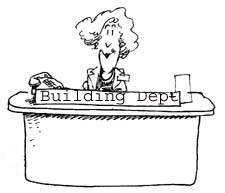|
Design your own house
Whether you build a new home or add on to your present home, the steps in the design and construction process are essentially the same. All projects should begin with a formal feasibility consultation at the construction site
with a qualified professional. The purpose
of the consultation is to determine whether you should or should not undertake your
project, or whether you should significantly modify or postpone it.
The Building Department doesn't care about zoning issues, only building codes. Your house can block everyone's sunlight, so long as it is solidly built and safe. Do your stairs have the right height and width and a proper handrail? Will your building stand up in an earthquake? Is the electrical wiring safe?
The Building Department studies those first three sheets but also looks carefully at the remaining drawings which show the construction details. But the construction details represent a lot of work and money spent. Wouldn't it be a shame if you turned in a complete set of drawings, including all the construction details, only to find out that you hadn't conformed the Zoning restrictions and couldn't build what was proposed? In that case, you would have to redesign the first three sheets and pay to have most of the construction details redrawn. The point is that every design process should start with a trip or at least a call to the Zoning Department. Find out what the zoning requirements are, and make sure that the proposed building will meet them before drawing a complete set of plans to turn in for your permit. Many zoning departments provide handouts that show the typical setback, height requirements and so on for lots in their city. You can also get the information by talking to a Planner(not a clerk) on the phone or at the Zoning desk. However you do it, get this critical information at the outset and make sure that your design conforms to Zoning's requirements. The Steps in the Design Process
The Program, as noted above, is the client's list of requirements - the size of a house or addition, the number of bedrooms, special access, a large or small kitchen, an art studio, separate quarters for a grandparent and so on. The Program is discussed in a general way during the Feasibility Consultation, but enlarged and refined at the beginning of the design phase. Once the Program is completely determined, Preliminary Design, the production of schematic drawings and sketches, begins. New houses and additions to existing houses are designed over different "templates." A new house is designed using tracing paper over a blank "site plan," or scaled drawing of the property the house will be built on. The site plan shows only the property lines and other features of the site such as slope contours, wells and trees.
Preliminary Design consists of making sketches on tracing paper over templates-- bare site plans or as-built drawings. Once the designer or architect has produced some sketches, which are really just attempts to translate the client`s ideas onto paper, he or she should show them to the client before spending time on detailed drawings. If the designer's vision matches that of the client's, the Design Development phase, wherein the drawings are refined, begins. Typically, several designer-client meetings take place during Design Development. When most of the details are worked out - usually at least to the level of the placement of kitchen cabinets, if not the actual number of drawers in each - the Construction Document phase begins. Construction Documents are an elaboration of the basic plans worked out by the designer and client. The documents consist first the basic design drawings - site plan, floor plans and elevations - and also contain several sheets of "detail drawings" that show how the house or addition will be built, how beams will connect to posts, what supports the roof and so on. Normally, the drawings will be accompanied by a set of engineer's calculations showing that the proposed structure is sound and will resist earthquake and wind forces. In California, an energy performance report specifying insulation values, heater type and so on is also required. The end product of the design process, then, is a set of plans and related documents showing what the house or addition will look like and how it will be built. When the plans are complete, you can apply for your building permit. Obtaining your permit
Plans are frequently returned to the designer for minor corrections. This is "normal business," and it is more or less expected that such a complicated set of documents may contain mistakes. Typically, the designer makes the corrections and returns the plans to the Building Department, which, duly noting the corrections, approves the plans. When you or your contractor picks up your Building Permit, you are given several pieces of paper. KEEP ALL OF THEM. Your Building Permit proper should be posted prominently on your property. Your inspection card, the only recorded proof that your inspector has approved the various phases of your construction, should remain safely on the site. Finally, a copy of your approved plans, complete with the Building Department's stamps and signatures, should stay with the inspection card. The approved plans are used by the Building Inspector to make sure that the building is built as shown, complete with all the proper connections and fasteners, right-sized posts, beams and so on. Building Departments typically take three to six weeks to approve plans. Construction Although it seems obvious, it must be said: Construction projects go best when they are well planned. The design process, which takes several months to complete, is only part of planning for construction. Numerous arrangements must be made, from finding a place to store the client's possessions to getting the roofers, plumbers and electricians on line. At points along the way, the work will need to be inspected by the city. The Golden Rule for inspections is that you should NEVER close or cover anything that needs to be inspected before it has been inspected (if in doubt about the need, call your inspector). Don't cover your bathroom walls with sheetrock, for example, before your inspector has had a chance to look at the plumbing and wiring within the walls. When all the work is complete and the site cleaned up, you will need a Final Inspection before the Building Department issues your Certificate of Occupancy, allowing you to move into your dream house. Good Luck! |
 Many people are confused or frightened by the complexities of the design and construction process. Should they call a contractor at the beginning, or have plans drawn first? Who draws the plans, and who does the building? Is a structural engineer's stamp required? When do they need a permit, and how do they get one?
Many people are confused or frightened by the complexities of the design and construction process. Should they call a contractor at the beginning, or have plans drawn first? Who draws the plans, and who does the building? Is a structural engineer's stamp required? When do they need a permit, and how do they get one?
 Before you begin construction on your house or addition, you must have a Building Permit issued by the local Building Department. To get a Permit, you must show the Department a complete set of plans for your project. Those plans typically include eight to twelve sheets of drawings along with structural performance calculations provided by an engineer and an energy performance report for the proposed building. An identical set of plans and
specifications is used by the contractor or builder in the construction of your house or addition. The plans are usually produced by an architect or designer who offers several types of design services.
Before you begin construction on your house or addition, you must have a Building Permit issued by the local Building Department. To get a Permit, you must show the Department a complete set of plans for your project. Those plans typically include eight to twelve sheets of drawings along with structural performance calculations provided by an engineer and an energy performance report for the proposed building. An identical set of plans and
specifications is used by the contractor or builder in the construction of your house or addition. The plans are usually produced by an architect or designer who offers several types of design services.
 While both departments use the same set of drawings, Zoning is concerned with the first three sheets of a standard drawing set, the site plan, floor plans and elevations. Those sheets show the aspects of the structure that affect the neighbors - where the proposed building will sit on the lot, how much open space it will occupy, how tall it will be
and so on.
While both departments use the same set of drawings, Zoning is concerned with the first three sheets of a standard drawing set, the site plan, floor plans and elevations. Those sheets show the aspects of the structure that affect the neighbors - where the proposed building will sit on the lot, how much open space it will occupy, how tall it will be
and so on.
 Design is the process of putting your dreams and ideas on paper using a set of drawing conventions, symbols and terms that are understood by everyone in the construction business including the designer or architect, building inspector, contractor, carpenter, plumber and electrician. The design process has four phases:
Design is the process of putting your dreams and ideas on paper using a set of drawing conventions, symbols and terms that are understood by everyone in the construction business including the designer or architect, building inspector, contractor, carpenter, plumber and electrician. The design process has four phases:
 Additions are designed over a set of "as-built" drawings - scaled drawings of the existing house as it has been built. Three types of as-built drawings - a site plan, floor plans and elevations are needed to completely describe a house. Since as-built drawings of most houses have been lost over the years, clients building additions usually have to pay to have such drawings produced before preliminary design can begin.
Additions are designed over a set of "as-built" drawings - scaled drawings of the existing house as it has been built. Three types of as-built drawings - a site plan, floor plans and elevations are needed to completely describe a house. Since as-built drawings of most houses have been lost over the years, clients building additions usually have to pay to have such drawings produced before preliminary design can begin.
